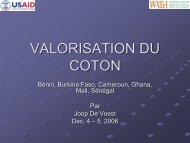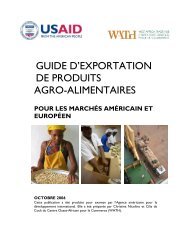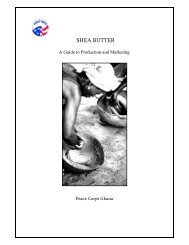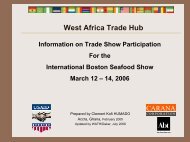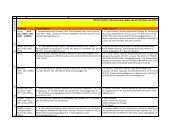A Brief Introduction to Textile Processing - AGOA Export Toolkit
A Brief Introduction to Textile Processing - AGOA Export Toolkit
A Brief Introduction to Textile Processing - AGOA Export Toolkit
Create successful ePaper yourself
Turn your PDF publications into a flip-book with our unique Google optimized e-Paper software.
knit fabric is stretched, it will bounce back <strong>to</strong> its original shape. This characteristic has been highly<br />
prized by consumers.<br />
Yarn Preparation<br />
Fabric manufacturing requires preparation of the yarn before the yarn can be interlaced (woven) or<br />
looped <strong>to</strong>gether (knit) <strong>to</strong> form the fabric. Yarn preparation involves several steps that vary depending<br />
upon whether the yarn will be used <strong>to</strong> weave or <strong>to</strong> knit a fabric.<br />
Because of the tension placed on warp yarn, and the abrasion it faces during the weaving process,<br />
warp yarn must be sized and / or lubricated for added strength, and so yarns will easily slip past one<br />
another during the weaving process without catching and breaking. Generally starch is applied <strong>to</strong> the<br />
yarn, as well as some sort of slippery lubricating agent. This lubricant / starch is called “sizing.”<br />
Depending upon the type of fiber and yarn these may be added at various points during the yarn<br />
forming process. Sizing is not added <strong>to</strong> yarn used for knit fabrics.<br />
Cones of yarn are placed in<strong>to</strong> a large frame called a creel. Each creel holds hundreds of individual<br />
cones, with guide wires <strong>to</strong> position each piece of yarn <strong>to</strong>ward a device that winds yarn on<strong>to</strong> a large<br />
beam. A warp beam resembles a giant spool of thread, but with hundreds of individual yarns (ends)<br />
wound next <strong>to</strong> each other around the beam rather than one yarn wound around the spool. Each<br />
individual yarn is called an end. Normally there are between 19 and 70 ends per cm.<br />
Below: yarn creel<br />
Woven fabric manufacturing<br />
Above left: preparing <strong>to</strong> wind warp beam<br />
Above right: full warp beam ready <strong>to</strong> be put on<strong>to</strong> a loom<br />
Step 1. Loom preparation. The process of setting up the loom (threading each individual warp ends<br />
in<strong>to</strong> the proper position on the loom) is a lengthy, painstaking process but is critical <strong>to</strong> the quality of<br />
the woven fabric. Any mistakes made during the set – up will run the entire length of the fabric. It<br />
cannot be corrected without rethreading part or all of the loom.<br />
Step 2. Weaving. Depending upon the exact pattern in which the warp and weft yarns are<br />
interwoven, the resulting fabric may have one appearance (pattern), or another. In order <strong>to</strong> hold the<br />
yarns <strong>to</strong>gether in<strong>to</strong> a fabric, and <strong>to</strong> create the specific pattern desired, selected warp yarns are raised<br />
and separated from other warp yarns. The weft yarn is placed between this “shed” or triangular<br />
separation of warp yarns. Before the yarn is brought back across the warp yarns a second time, the<br />
warp yarns are lowered, and different warp yarns are raised. The weft yarn is brought back between<br />
the new shed, and beaten in<strong>to</strong> place. This process is repeated hundreds of time a minute <strong>to</strong> form the<br />
fabric.<br />
Prepared by Margaret Bishop and Brent Smith for the West Africa Trade Hub 8/04 8



